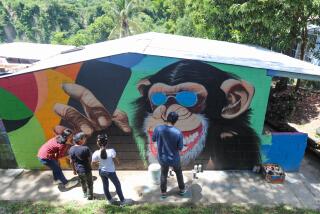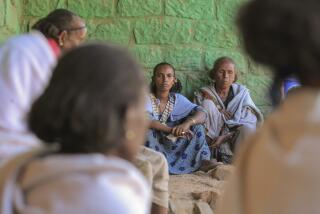Asmara--a Genteel Survivor in a Grim Land : Ethiopia: Lonely outpost of government control fends off drought and rebels to retain a liveliness seen nowhere else in this war-torn country.
- Share via
ASMARA, Ethiopia — A light-colored van swept around a corner, passing a clutch of soldiers and momentarily slowing near a crowd of children playing in the street.
“Italiano! Italiano!” the children shouted, running after the vehicle and its familiar driver.
“In this town,” the driver explained, “ ‘Italiano’ means any foreigner who is not a Russian. There are Italianos, and there are Russians.”
It is not unusual to hear a resident of this striking northern city, a lonely outpost of Ethiopian government control almost entirely surrounded by Eritrean rebels, talk in terms of the foreigners who have invaded, occupied and built up the place over the years.
It was the Italians who turned Asmara from a rough urban agglomeration into a city during their adventure in Eritrean colonialism beginning in 1890. The British evicted the Italians during the war year of 1941. Later, 5,000 Americans poured their dollars and their pop culture into the place while staffing a U.S. radio relay station on the edge of town from the late 1960s until 1976.
More recently came a less welcome occupation group: Soviet military advisers, stationed at the Eritrean front to help the Ethiopians fight rebels.
Today, Asmara is Ethiopia’s second-largest city and its most cosmopolitan, the beneficiary of the land’s freshest climate and most stunning vistas. But all its glories are overlaid by the mean reality of the rocky and mountainous landscape enveloping it. Eritrea, of which Asmara is the capital, is Ethiopia’s grimmest province.
Over this land the secessionist guerrillas of the Eritrean People’s Liberation Front (EPLF) have fought a 28-year war of independence.
Meanwhile, the region’s capricious climate, which throughout history has brought drought roughly every 11 years, has bequeathed crop failures in four of the last six years.
This year the rains failed again; Eritrea’s crop is so bad that international relief agencies estimate more than a million of its people will need emergency food aid to avert starvation in the next year.
Taken together, the drought and the war make for an atmosphere of unexampled disaster. It is relieved only by Asmara’s own Brigadoon-like municipal air.
Here, perhaps 200 miles from the encroaching Sudan desert, deep within a ring of virtually impassible mountains and on a highland plain accessible only by air and a serpentine mountain road running 60 miles in from the Red Sea, lies a city of mysterious grace.
The sidewalks of even its most modest alleys, let alone its wide boulevards, are paved with intricately patterned tiles--like so much else, a legacy of Italian artisans who trained the Eritreans in their craft. Two local factories still produce the tiles.
Everything gives an impression of impeccable tidiness, from the streets kept spotless by an army of 300 sweepers, some of them father-and-child teams, to the whitewashed trunks of the olive trees lining every promenade.
Turn a corner and one is likely to be surprised by an Art Deco gas station with sweeping curves and porthole windows, painted in fresh pastel.
“The Italians built this city. They deserve the credit, no doubt about that,” says Mayor Afwerk Behane. “But we have tried to keep it maintained.”
Their success might owe much to the Eritreans’ native resourcefulness, perhaps a legacy of the land’s location at an ancient trading crossroads fertilized by a mix of culture and money.
Eritrea today harbors 30% of Ethiopia’s entire industrial base, meager as it is. Asmara University turns out so many trained engineers that the region exports them to the rest of the country. The skills of the province’s mechanics, silversmiths and bureaucrats alike are bywords.
Asmara offers a liveliness seen nowhere else in Ethiopia. Every night until midnight curfew, in countless one- or two-room bistros, one finds a scene like that in the Flower Bar, where a tough, gum-snapping waitress works the floor and a proprietress of undisputed authority keeps order from her cash register in front of a black-and-white photo snapped in her beauty-queen days 40 years ago.
Their taste set by the pop-music radio station that the Americans operated here for their own enjoyment, a dozen people sit around listening to old American 45s blaring from a pair of exhausted speakers.
On Sunday afternoons, the scene shifts to a spot like the Afwerk Woldu Cafe on National Avenue. Every seat at the 10 tables inside is taken by someone in his Sunday best, aperitif and pastry set on the tables before them.
In a corner, a waiter scoops gelato out of a mechanical churn into tiny cones that he hands out the window to clients on the street; high on the wall, where other Ethiopian establishments display the obligatory portrait of President Mengistu Haile Mariam, is a photo of an American astronaut on the moon.
Inescapably, this surface prosperity shows its cracks. At first glance, one is struck by shops filled to the brim with imported goods of every description, some sent to family members by Eritreans at work in the oil industry of the Persian Gulf states.
But a second look discloses that most of these goods are quite ancient, cheap plastic cameras from Hong Kong or rusted toys gathering dust. The people crowding a small shop are not customers but the owner’s friends, idly passing the time. Despite Asmara’s surface affluence, three decades of war and eons of natural disaster have sapped the city-dwellers’ ability to buy anything but essentials.
Asmara’s consumer economy tracks the progress of a drought as precisely as any meteorological instrument. Recently, the price of millet soared to the equivalent of 50 cents a pound, from 30 cents, as the meager harvest started to come in.
More disturbing, in its way, is the drop in the price of meat, to $1.25 a pound from $2.50. Natives of Asmara are experienced in reading this omen: It means the farmers are driving their herds to market now, in desperation, because they know the drought will kill off any animals not already slaughtered.
Next year, the price will soar out of reach because all the animals will have perished or been butchered. No one here takes the sight of herds of bony animals being driven up Asmara’s boulevards to the municipal market as a sign of prosperity.
To many residents, Asmara has lived a succession of golden ages, but today does not qualify. People over 40 recall the pre-revolutionary days of Emperor Haile Selassie, 15 years ago, as Asmara’s prime. Many older shopkeepers dismiss their seemingly full shelves as a shadow of the riches that could once have been had in their shops.
Others think of the halcyon days as the period of the Americans, especially compared to the more recent time of the Soviets.
“The Americans fed you and clothed you,” says a native. “From their rent you could build yourself a new house. The Russians took things instead. They would come into the stores and steal potatoes. They’re the kind of people who would share one Coke in a bar.”
Always scarce, water is already being rationed, at an alarmingly early point in the season. And looming large over the city’s future is its vulnerable lifeline, a 60-mile mountain road to the Red Sea port of Massawa, from which it gets all its fuel and other key supplies. It is an article of faith here that if the rebels choose to make Asmara fall, they need only cut the road.
The public and officials seem to agree that all that is holding the guerrillas back is the prospect, however faint, that peace talks with the government may bear fruit. The preliminary phase of the talks recently adjourned in Atlanta and are scheduled to resume under the mediation of former U.S. President Jimmy Carter in Nairobi, Kenya, on Nov. 18.
There is little question that Asmara’s government-appointed leaders, who are themselves Eritreans, know that much of the city’s population sympathizes with the rebels. Asked bluntly how many of their constituents support the liberation front, Eritrea’s deputy administrator, Isaak Tsegay, cracks a nervous smile.
“We have never attempted to find out,” he says. “But we think they support us (the government).”
Nevertheless, Asmara has the look of an armed camp. Sullen soldiers, almost all of them shipped in from elsewhere in the country, occupy virtually every street corner, huddled in groups. Some estimates place the Asmara garrison at 150,000 soldiers. That is half the Ethiopian army, itself the largest in sub-Saharan Africa.
“The soldiers in Eritrea know they are soldiers on an island,” says a guerrilla supporter with satisfaction. “The EPLF is everywhere.”
Local officials maintain that the soldiers are needed for security, although in 28 years the fighting has never once entered the streets of Asmara. Instead, the garrison itself seems to provoke considerable local resentment.
Every road out of town is marked by a military roadblock at the city limits, and no one may pass without a permit. On a typical day recently, trucks and cars were lined up on either side to have their cargoes and trunks searched. A peasant woman laid her load of eggs out on the red dust at one side under one infantryman’s glare.
“They will just open the drawers of your wife and check her pants,” complains a resentful Asmara professional.
There seem to be few Asmara families untouched by the arbitrary repression of the Mengistu regime. Eritreans are often rounded up and jailed on suspicion of harboring rebel sympathies; residents of the city talk politics guardedly even with friends.
“The people are really afraid of the police,” says one resident. “It’s very easy here to get thrown in jail.”
“The government knows that almost every Eritrean wants to be independent (of Ethiopia),” adds a professional here. “But they don’t want them to say it in words.”
Just outside the city limits, the signs of war are evident. On the edge of town, at a settlement called Hazhaz, 2,400 war refugees, 2,000 of them children, live in vast corrugated-metal barracks, waiting for the day when they can return to their farms in neighboring Tigre province.
Scarcely a hilltop on the main road southeast out of Asmara is unadorned with an artillery bunker fashioned out of boulders. About six miles past the city limits, the road is marred by more than a dozen blackened patches marking the site of one of the last major attacks nearby, a rebel assault on a 20-truck food convoy in October, 1987.
But there seems little that can completely erase Asmara’s cultivated charm, obscured as it might be by layers of privation and struggle. One man who moved to the city about three years ago says his friends described pre-revolutionary Asmara as a paradise. Now, he remarks on how things have gone downhill since his arrival:
“Water is scarcer. Food is more difficult to get than three years ago--butter now might not be available for two months, where before it would be two weeks. But I really agree with the idea that before the revolution, this place must have been paradise.”
More to Read
Sign up for Essential California
The most important California stories and recommendations in your inbox every morning.
You may occasionally receive promotional content from the Los Angeles Times.










